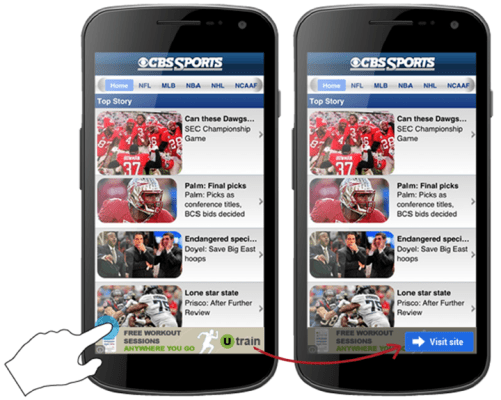Google is announcing a new mobile ad feature today, one that the company says should alleviate the “fat finger” issue, where you accidentally tap on a banner ad on your phone. That’s annoying for the consumer, since they’re directed to a site that they had no intention of visiting, and it’s bad for the advertiser too, since they’re paying for a click that doesn’t have much value.
Jonathan Alferness, Google’s product director for mobile ads, said the company has already tackled the problem in its text and app promotion ad formats — those ads include a blue arrow, and if you tap on the ad, but not on the arrow, it enlarges into a “visit site” button, which you have to tap again to actually go to the advertiser’s site. In other words, if there’s some ambiguity about whether you really meant to select the ad, Google will ask you to confirm that it was intentional. The format was first tested a few years ago and became more widely available after AdMob was integrated with AdWords in June.
Now Google is taking a similar “confirmed clicks” approach to its other major mobile ad format, in-app image ad banners. In this case, the ad doesn’t start out with a blue arrow, and if you tap on the center of the banner, it’s assumed that you really meant to do that, so you’re taken to the advertiser’s site. If, on the other hand, you tap on the outer border of on ad, that same blue “visit site” button will appear, which you have to select in order to confirm your intentions. (You can see the process in the screenshot above.)
Google has already been testing the new format, and as of today, Alferness said it’s “fully launched” — in other words, it should be available in all of the image ad banners it serves in smartphone apps. The tests, according to a Google blog post, showed that “confirmed clicks notably improve mobile conversion rates” while also causing “a slight decrease in clickthrough rate as accidental clicks are avoided.”
I asked Alferness if there’s a tradeoff here between the desire for more clicks (which is how Google and the publishers get paid for the ads) and a desire to make those clicks more valuable. He countered that everything in digital advertising involves some kind of tradeoff, but in this case the company is “really looking to attract long-term valuable users,” and even in the short-term, the tradeoff isn’t too significant.
I also asked how well the text version of the confirmed clicks feature had performed, and Alferness said he couldn’t go into specifics, since we’re in the quiet period before Google’s next earnings report. However, he did say that the results were “pretty phenomenal” and that “advertisers have responded very, very strongly.”
As Google has developed these new features, Alferness told me it hasn’t had any real existing models to follow. However, whether or not other companies copy the specific format, he said he’s hoping they follow Google’s lead in trying to address the issue.
